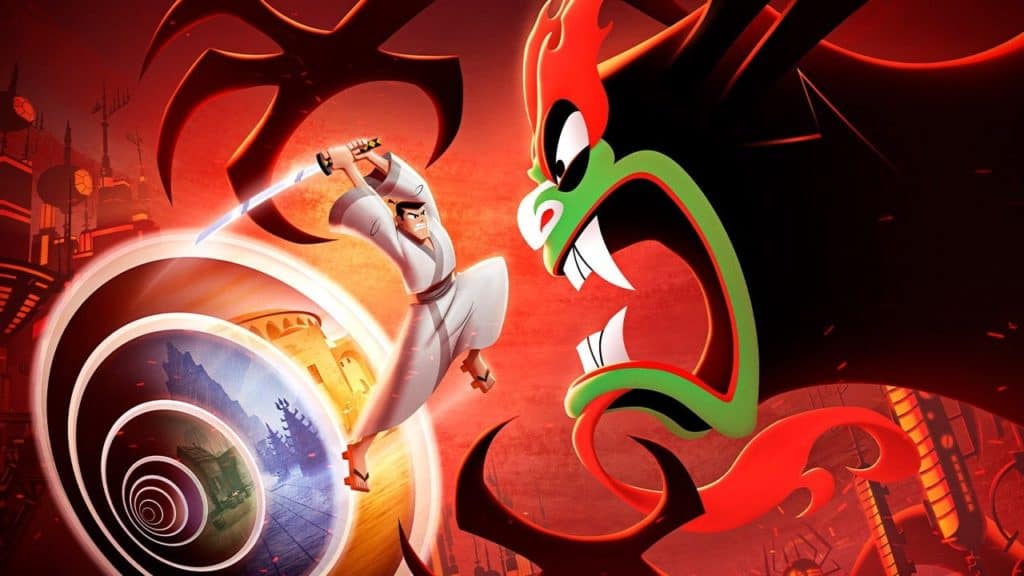Video Gamer is reader-supported. When you buy through links on our site, we may earn an affiliate commission. Prices subject to change. Learn more
How do you battle an ancient demon that can take any form, dripping and whipping its oil-black body into a wardrobe of hostile shapes? If you are Jack, a warrior tossed on the frothy waves of time into an unrecognisable future, then a magic sword wouldn’t hurt. If, however, you are Genndy Tartakovsky, the Russian-American artist and creator of Samurai Jack—a venerated series that aired from 2001 to 2004, with a final season in 2017—you do it by levelling the playing field, inking a world as crude and quicksilver as the beast that blights it. Tartakovsky’s animation has all the freedom and fever of thought. Witness Jack in the first episode, in his foe’s lair, standing atop a tongue of frozen flame; or peer into the backgrounds, at the rollered paint of foliage and cloud. Lines, like rules, are broken and bent; colours throb and cool like moods. How do you capture that in a video game? A magic pen wouldn’t hurt.
Rising gamely to the task is Tokyo-based studio Soleil Ltd., with Samurai Jack: Battle Through Time. It’s one of those rare games whose title triples as a pitch, a plot recap, and an instruction, (see also: Destroy All Humans!, Out Run, and Journey). Any anxious fans, fretting their hours upon the thought of time being out of joint, need not worry; the story sees Jack, at the show’s finale, being booted through a temporal backdoor. “I have cast you down into a place with no future or past,” says Aku, the shapeshifter in question. “A place between time.” In other words, a place with no consequence: Tartakovsky’s conclusion will remain unruffled, while we zip through the cartoon’s crowning moments.

If that setup sounds paper-thin, that’s because it is, and we should be thankful. Frankly, more plots should aim for the papery—for the same sharp-edged blankness from which the show drew much of its wordless power. I was relieved, early on in Battle Through Time, to find the narrative, which was written by Tartakovsky and Darrick Bachman, touched off with a scene as simple as Jack landing in a familiar spot and declaring, “Something doesn’t feel right.” The great thing about that line is that, depending on your taste for the game’s visuals, it may ring with irony.
The art direction, lead by Marcos Ramos, has the look—longing and synthetic—of games like Batman: Vengeance and The Simpsons: Hit & Run. It’s as if, in their inflation from the flat plane of their source to three dimensions, they were cooked up not by an office of developers but by cake makers. Here the surfaces have the smooth, spongy shine of icing; one level, set in the baked crust of a city, amidst crumbling domes and topped with a sky of stucco pink, seemed better off eaten than beaten. But, though it lacks the jagged speed of the animated series—whose action, quickened with cuts, wasn’t weighed down or dulled by a Z axis—I loved seeing old sights rendered fresh and oddly full. The metropolis, for example, into which Jack plummets in the pilot episode, even now refuses to be cramped by sense; the skyline, despite its added depth, still seems to teem with angry kitchen utensils. Polygons have done little to dent the unreality of the place, and, as I settled on the art style, I couldn’t help but think, Something does feel right.

The same could be said of the combat: a winning, if unadventurous blend of blocks, parries, projectiles, light and heavy strikes strung into combos, and the occasional loosing of a charged-up power move, in which Jack chews through his enemies like a buzzsaw. By way of pleasant distraction, there’s a menuful of weapons (though none were enough to tempt me away from Jack’s signature sword) and upgrades, and about four kinds of currency to collect. At first, I couldn’t think what the game reminded me of, but eventually it hit me: God of War, from 2005! Watch the way Jack opens a treasure chest, with a nice hinge-cracking heave; and the way the camera wafts out to a wide shot in motion, humbling the hero against a hulking backdrop. Thus, we have the chance to revisit not only the toon-bright vistas of Jack’s adventure but also the heyday of the hack-and-slash—a battle through time, indeed.
Given that it’s the product of a developer comprising (according to its website) 98 employees, it has the pleasing feel of a middleweight effort. It’s powered by AA batteries, so to speak, with a layer of polish and precision—granted, in part, by modern technology (it runs in Unreal Engine 4)—not possible for the equivalent efforts of 15 or so years ago. In fact, one such equivalent effort we might consider is Samurai Jack: The Shadow of Aku, from 2004; patched together by three developers and published by Sega, it wreaked of cash-in and cast no shadow at all. And, as I reached the end of Battle Through Time (which, at nine hours long, didn’t feel like one) it occurred to me that perhaps Jack’s job isn’t quite to banish the shadow of Aku but, rather, to banish The Shadow of Aku: the notion that the second-tier entry or the licensed release need be lesser. What’s on offer here is a version of what would only have been available, back then, from a top-flight studio; a haven for those who crave a hit of Tartakovsky; and a hack-and-slash hardly ahead of the curve but happy to polish the past. In short, a place between time.
Developer: Soleil Ltd.
Publisher: Adult Swim Games
Available on: PlayStation 4 [reviewed on], Xbox One, Nintendo Switch, PC
Release date: August 21, 2020
To check what a review score means from us, click here.

